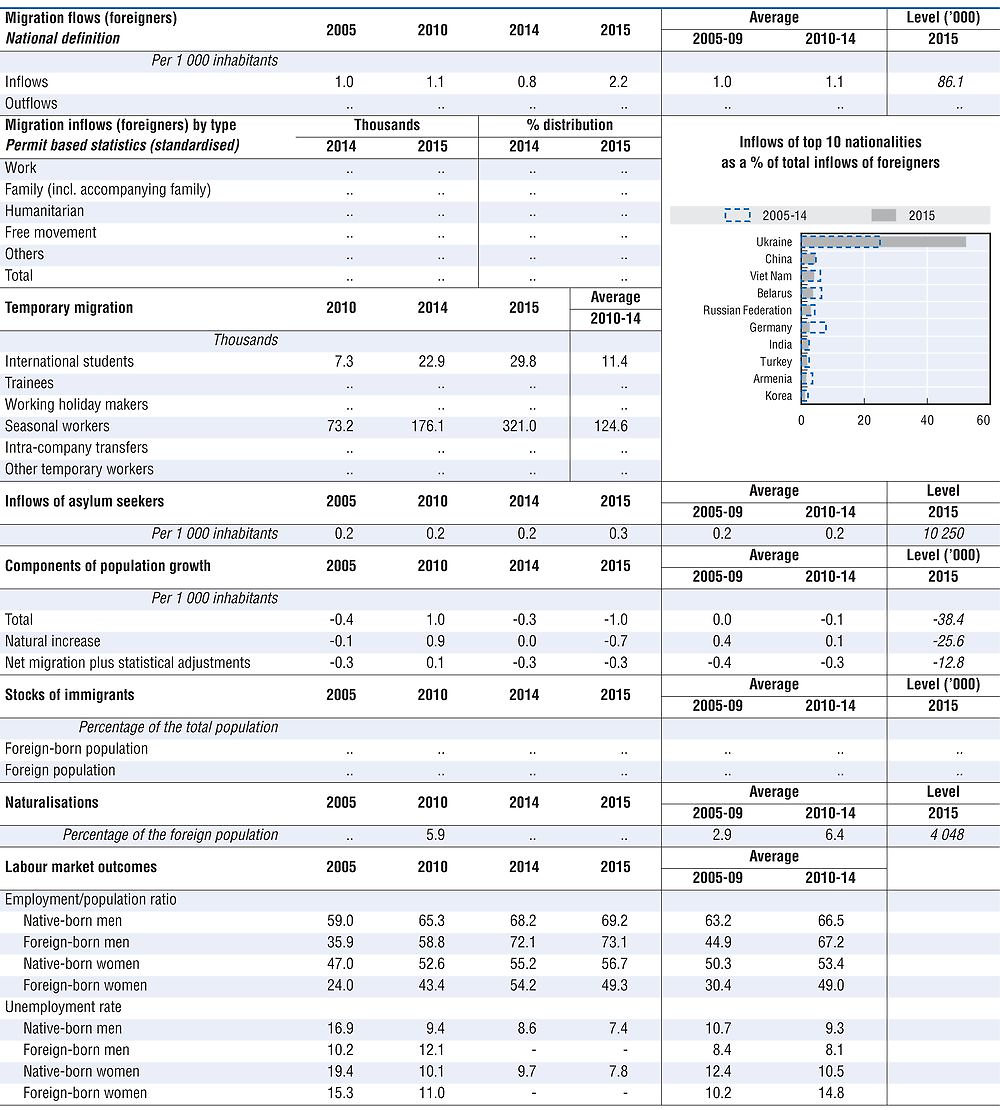Poland
In 2015 large migration inflows continued, with 91 400 persons who arrived from abroad registered for a stay longer than three months, a similar level to 2014 and 13% more than in 2013. The largest immigration inflows were from Ukraine: in 2015 they represented around 43% of the total number of foreigners compared with 40% and 33% respectively 2014 and 2013. Belarussians (4.7%), Vietnamese (4.4%), Germans (3.9%), Chinese (3.5%) and Russians (3.2%) were the other main groups.
Data on residence permits show similar strong increase, largely driven by the new regulations introduced in May 2014, the regularisation process which started in 2012 and the large-scale immigration of Ukrainian citizens. In 2015, 65 000 temporary residence permits were issued (a 35% increase on 2014); as were 9 900 permanent residence permits (+33%) while there were 9 000 stay registrations by EU citizens (+5%). Overall 77 700 residence permits were issued in 2015 compared with 44 300 in 2013.
The number of work permits issued to third-country nationals continues to rise and reached 127 400 in 2016, a 94% increase over 2015. Poland’s temporary work programme for citizens of neighbouring countries (Belarus, Russia and Ukraine) and Moldova, Georgia and Armenia continued to expand rapidly. This programme, in which employers make declarations of intent to hire a foreign worker for employment for up to six out of 12 months, saw 1.3 million registered declarations in 2016 (68% growth in comparison to 2015). Together, the increase in work permits and the temporary programme reflect the importance of foreign labour in the Polish economy, notably in agriculture, construction and household services.
Around 57 100 international students were registered in Poland in Academic Year 2015/16, a significant increase of about 24% over the previous year. They were predominantly from Ukraine (54%), but also from Belarus (8%), Norway, Sweden, Spain, Turkey, the Russian Federation and Lithuania.
In 2015, an estimated 263 000 Polish citizens moved abroad for a stay longer than three months. About 95% of them were labour migrants. The top destinations were the United Kingdom and Germany. Over the period 2011-15, the estimated numbers of emigrants (de)registering for permanent residence was around 129 400 (a reduction of 50 % compared with 2001-10).
The number of asylum applicants stayed on a similar level as in 2015, however their number is still low compared with other EU countries. In 2016 there were 12 300 asylum applicants, covered by 5 000 applications. 91% of all applications were lodged by three nationalities. The biggest groups to apply for asylum were Russian (8 900, 73% of total), Ukrainian (1 300, 11%) and Tajik citizens (900, 7%).
In 2016 the government presented draft amendments to the Act on foreigners. One of the most important proposed changes relates to the access of foreigners to permanent residence status. Immigrants applying for both a permanent residence permit and an EU long-term resident permit need to present a state certificate confirming the knowledge of the Polish language. Only selected categories of foreigners are to be exempted from this requirement: foreigners of Polish origin; holders of the Polish Card (people of Polish ancestry or connection to former Soviet countries); foreigners granted asylum; victims of human trafficking; children born in Poland and children under the age of 16. Other proposals include the introduction of new types of temporary residence and work permits for intra-company transferees, a special type of a temporary residence and work permit for migrants with skills needed by the Polish economy (holders of such a permit are to be given easier access to a permanent residence permit) and a simplified legalisation procedure for international graduates of Polish universities intending to look for a job in Poland.
In 2016 draft amendments to the Act on employment promotion and labour market institutions were proposed with the aim of implementing the EU Directive regarding seasonal workers and better management of temporary migration in Poland. A new type of work permit is designed for seasonal work (for up to nine months during the calendar year in agriculture, horticulture and tourism for all non-EU nationals, whereas for nationals of Armenia, Belarus, Georgia, Moldova, Russia and Ukraine there are other facilitations (without labour market test requirements). Some amendments are designed to the above mentioned short-term scheme only for nationals of Armenia, Belarus, Georgia, Moldova, Russia and Ukraine (up to six months during twelve consecutive months) to be applied in all sectors except seasonal work. These proposals are to enter into law from 2018.

